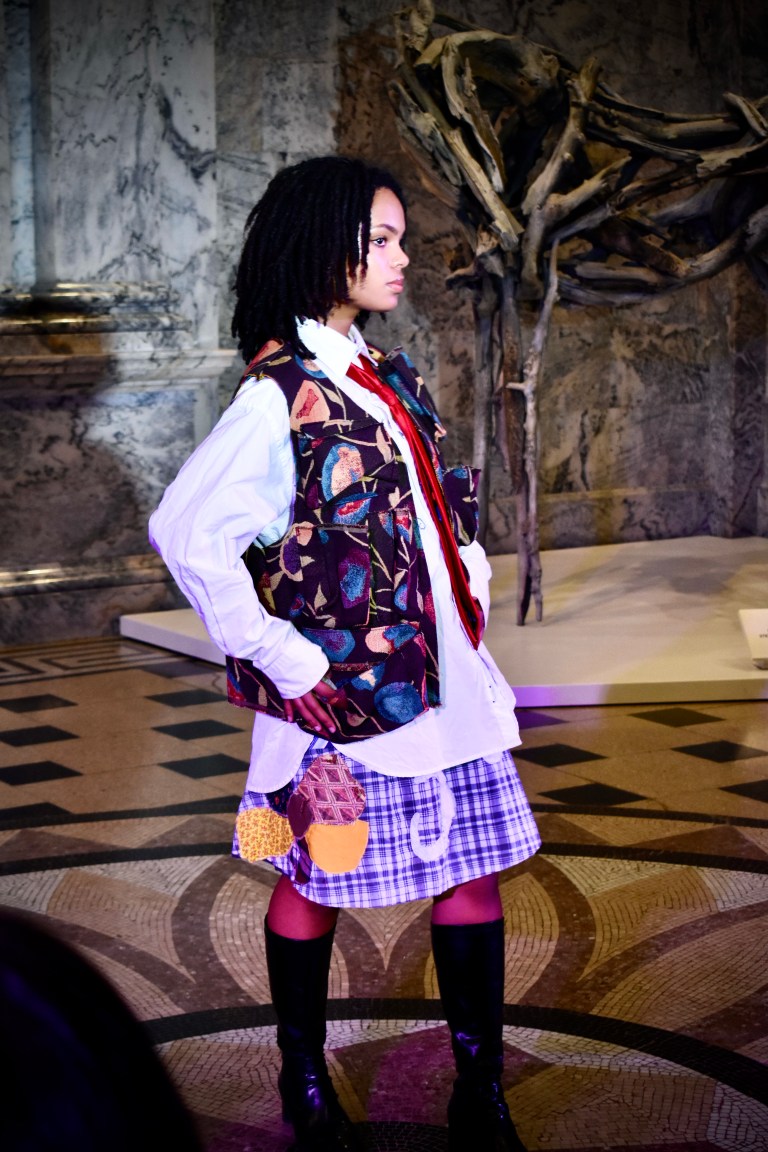The Cantor Arts Center was the place to be this Thursday night — just ask the hundreds of Stanford students who dressed their finest in attendance for the Museum Nights: FASHION X CANTOR event.
The interactive art experience was put on by Stanford FashionX, a pre-professional organization for students interested in design and the fashion industry. It offered two student-led galleries featuring new exhibitions and media installations, as well as a runway show where Stanford student models wore cutting-edge pieces designed by graduate and undergraduate Stanford students.
I was immediately struck by the event’s scale and detailed execution. Together, they made for a fantastical night centered around celebrating student fashion. The Cantor acted as a natural runway, with gorgeous arches and natural acoustics for the music that played over the runway show.
“In FashionX, we believe that fashion is art, and the Cantor Arts Center was the perfect venue to host the designers’ work,” said FashionX Executive Director Cole Crichton ’24 regarding the venue.
The designs seemed larger than life. Cohesive collections highlighted the fashion show’s theme, “The Other Side.”

“To me, the theme, ‘The Other Side,’ felt like a reconsideration of what it means to be at Stanford. There are certainly times when the school can feel hegemonic in its tech-y rigidity and utility,” said designer Avery Louis ’25. “I wanted to highlight the amazing latent creativity at Stanford and allow all of our excessiveness to enter the limelight.”
The theme asked designers to examine the question of whether or not the grass is always greener on “the other side.” The designs brought forth a discussion of opulence and scarcity with each designer’s individual approach to theme.
“Fashion demands technical skills, intentionality and effective scholarship. It is a rich combination of individual and cultural expression — a fact which is often overlooked at Stanford,” said Crichton. “With the theme, we wanted to create an event and opportunity for artists on campus where they felt like we had reached this ‘other side.’”
The show’s designers took this theme and applied it by examining the “other side” of sustainability, construction, materials and more. Some designs required over 100 hours of work, from creating the pieces to working with models to make sure the designs fit and prepping them for the runway.
Designers were chosen at the start of fall quarter after a large initial recruiting round. Anyone with a vision and path to garment construction was invited to design for the runway show. “First-time designers were welcome, and we provided resources such as access to Pigott Hall if they needed sewing machines and other supplies,” Crichton said.
Louis, who has been working on her designs since November, explained that some of her designs demanded more attention than the others and went through “several iterations.” Most of her pieces took 5 or 6 hours to sew, as well as countless hours spent drawing up designs and roaming around fabric shops looking for the right materials.
“Some of the pieces were particularly demanding and required doing things by hand, which, of course, took far longer,” said Louis.
Student models in the show struck poses and mesmerized the audience. Crowds lined the stairs and mezzanine in colorful black-tie fashion to catch a glimpse of the fierce models, most of whom were close friends of the designers.
Louis expressed that the models she chose were friends who she adored and whose “amazing” personalities she “wanted to express through the clothing.” The models were met with enthusiastic applause from the audience as cameras flashed to capture the moment.

“I’ve never seen so much creative energy in one space at Stanford. I felt so lucky Avery trusted me to wear her dress,” said model Alexandra Blum ’25, who wore one of four pieces from Louis. The two have long connected over film and art. “Watching her physically make her creations was so touching. The show was such a beautiful moment to uplift imagination in the community.”
Crichton expressed joy in putting on the event for Stanford students, and hopes for the FashionX event to become a yearly tradition. He also conveyed gratitude for the Cantor team for being “incredibly accommodating” and looks forward to continuing a relationship with them in the future.
“Making clothing is like turning yourself or your institution inside out — it sanctifies our bodies and extends their boundaries in a beautiful, vulnerable and reckless way,” Louis said.
I left the Cantor Arts Center with stars in my eyes from the designers, models, art installations, participants and Stanford FashionX’s production team, eager to attend their next event.
Editor’s Note: This article is a review and includes subjective thoughts, opinions and critiques.
